Digital Branding Strategies
What Are Popular Brand Names? Understanding Their Impact and Importance
Overview
Popular brand names hold substantial significance as they encapsulate a company’s identity, cultivate customer loyalty, and propel business success through adept marketing strategies. Strong brand identities, exemplified by industry leaders such as Apple and Nike, not only augment visibility and foster trust among consumers but also wield considerable influence over purchasing decisions. This underscores the critical nature of brand management in contemporary business practices.
Introduction
In an increasingly competitive marketplace, brand names have transcended their role as mere identifiers; they encapsulate the essence, values, and aspirations of a company. As businesses navigate the complexities of 2025, the significance of a strong brand name becomes paramount, influencing consumer loyalty and market visibility.
Iconic brands like Apple and Nike exemplify how strategic naming cultivates deep emotional connections with consumers, ultimately driving purchasing decisions. With a landscape saturated with choices, understanding the psychology behind brand names and the narratives they convey is essential for businesses aiming to resonate with diverse audiences.
This article delves into the multifaceted role of brand names, exploring their impact on consumer perception, loyalty, and overall business success, while offering insights into effective branding strategies that can elevate a company’s market presence.
The Significance of Brand Names in Today’s Market
Brand labels transcend mere recognition; they embody a company’s essence, values, and commitment to its customers. In the fiercely competitive landscape of 2025, an appealing label serves as a pivotal differentiator, nurturing customer loyalty and amplifying visibility. Notably, esteemed brands like Apple and Nike exemplify how strategic marketing can yield substantial market advantages, becoming synonymous with innovation and quality.
The emotional connections that consumers forge with prominent brand names significantly influence their purchasing decisions, underscoring the necessity for companies to invest in crafting memorable and impactful identities.
At WonderEight, we acknowledge that merely 29% of low-income shoppers place their trust in labels, in contrast to 38% of affluent consumers. This disparity highlights the critical need for companies to foster trust and credibility across diverse demographics. Our expertise in branding empowers organizations to cultivate robust identities that enhance loyalty and boost customer engagement.
As noted by Business Insider, the financial commitment companies allocate to logo design can range from entirely free to millions, reflecting the serious investment organizations make in their identity and its impact on consumer perception. Furthermore, case studies illustrate the profound effect of strong labels on customer loyalty. For instance, firms that emphasize employer branding can experience employee retention rates soaring by as much as 28%, which not only preserves talent but also cuts hiring costs by up to 50%.
This link between brand strength and loyalty extends beyond internal stakeholders to external consumers, reinforcing the concept that a well-crafted identity can yield significant competitive advantages.
In today’s marketplace, where consumer choices abound, the importance of identities cannot be overstated. They play a crucial role in shaping perceptions, influencing purchasing behaviors, and ultimately driving business success. At WonderEight, we are committed to guiding our clients in devising impactful strategies that resonate with their target audiences and enhance their industry presence.
Unpacking the Stories Behind Iconic Brand Names
The allure of numerous well-known brand names lies in their captivating histories, which significantly enhance their market appeal. For instance, the brand name ‘Nike’ draws inspiration from the Greek goddess of victory, encapsulating themes of triumph and excellence that resonate deeply with consumers. Likewise, ‘Pepsi’ traces its roots to the digestive enzyme pepsin, reflecting its original positioning as a health tonic.
These narratives not only illuminate the company’s heritage but also forge a stronger emotional connection with consumers, fostering loyalty and engagement.
In the current competitive landscape, compelling storytelling is paramount; research indicates that engaging narratives rank among the top factors influencing content effectiveness, with 57% of marketers underscoring their importance in establishing connections with audiences. Furthermore, the rise of platforms like Instagram, where over 500 million users engage with Stories daily, underscores the necessity for brands to communicate their messages in captivating formats.
As we approach 2025, the trend of data storytelling is anticipated to grow, with a remarkable 233% increase noted in recent years. This evolution suggests that brands must adapt their strategies to integrate meaningful, narrative-driven content that resonates with audiences. Case studies reveal that companies leveraging their unique narratives not only enhance client engagement but also positively shape brand perception.
For example, organizations that prioritize sustainability and diversity in their storytelling find that consumers are more inclined to spend, as highlighted by Huddle Creative, reflecting an upward trend in purchasing behaviors.
By understanding and harnessing the stories behind their identities, businesses can craft compelling narratives that reinforce their brand identity and cultivate deeper connections with their audience, ultimately driving engagement and loyalty.
![]()
The Psychology of Brand Names: How They Shape Consumer Perception
The psychology behind popular brand names plays a pivotal role in shaping buyer perceptions and actions. Research indicates that titles which are easy to pronounce and recall foster positive associations and build trust. For instance, studies demonstrate that consumers are significantly more inclined to select items with well-known brand names over lesser-known alternatives, even when the latter may offer superior quality.
This underscores the critical importance of phonetics and clarity in product naming for popular brands. Moreover, brand names that evoke positive imagery or emotions can substantially enhance customer loyalty and influence purchasing decisions. Emotionally connected customers are more than twice as valuable as those who are merely satisfied, highlighting the necessity of forging a strong emotional bond through effective branding.
Indeed, a signature color can boost recognition by an astounding 80%, further illustrating how visual elements complement the psychological effects of popular brand names. Expert insights emphasize that personalization has emerged as a vital component of marketing, enabling businesses to craft tailored experiences that resonate with individual clients. As Mrignayni Pandey notes, this approach is exemplified by companies like Amazon, which leverage data-driven suggestions to elevate customer engagement and loyalty.
Furthermore, case studies reveal that a company’s reputation significantly impacts job applicants’ decisions, with 69% of candidates opting out of offers from firms with a negative standing. This statistic underscores the competitive advantage of robust employer branding in attracting talent, closely tied to how identities are perceived in the marketplace.
In conclusion, the interplay between identity phonetics, emotional connection, and buyer behavior is essential for companies aiming to effectively influence purchasing choices. Grasping these psychological factors is crucial for developing impactful branding strategies that resonate with target audiences.
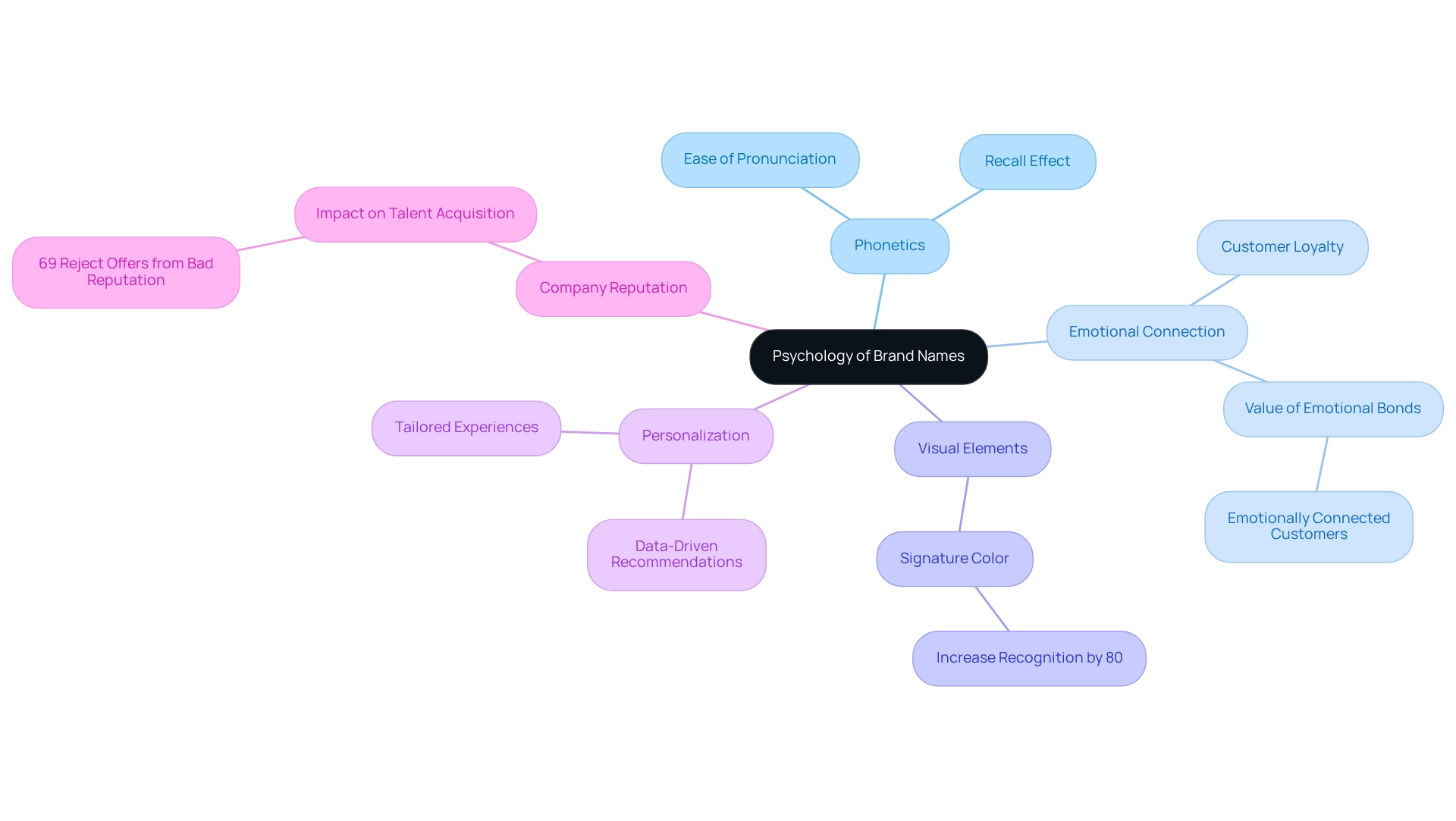
Crafting Memorable Brand Names: Strategies and Best Practices
Developing a memorable identity is a multifaceted process that relies on several key strategies. First and foremost, simplicity is crucial; a term that is easy to spell and pronounce enhances recall and recognition among consumers. This principle is evident in thriving companies such as ‘Coca-Cola’ and ‘Starbucks,’ which have embraced memorable and significant titles that connect profoundly with their audiences.
As Jason Moyer, Creative Director at Create Element, observes, “Mint’s branding, for example, is centered around simplicity and clarity. Their website and app design are clean and user-friendly, making financial management approachable for the average user.”
Additionally, the label should encapsulate the core values and mission of the business, offering a clear indication of what it represents. This alignment not only encourages customer loyalty but also helps in creating a strong market presence. In fact, research indicates that businesses with well-defined marketing strategies can anticipate revenue growth of 10-20%, underscoring the financial benefits of effective identity management.
Moreover, fewer than 10% of business-to-business (B2B) firms indicate having consistent identity, emphasizing the importance of a robust branding strategy.
Conducting thorough market research is another vital step in the naming process. Grasping customer preferences can greatly guide the creation of a name that attracts the intended audience. For instance, a study revealed that 46% of consumers are willing to pay more for labels they trust, emphasizing the importance of credibility in consumer decision-making.
This is further demonstrated by Smoopydoo’s investment in branding strategy and design, which led to increased customer loyalty and market share growth within two years.
Ultimately, evaluating possible titles with focus groups can provide essential insights, enabling companies to enhance their selections before confirming them. This iterative method not only improves the chances of success but also guarantees that the title resonates well with the intended audience. By adhering to these best practices, brand managers can create titles that not only stand out but also contribute to long-term business success.
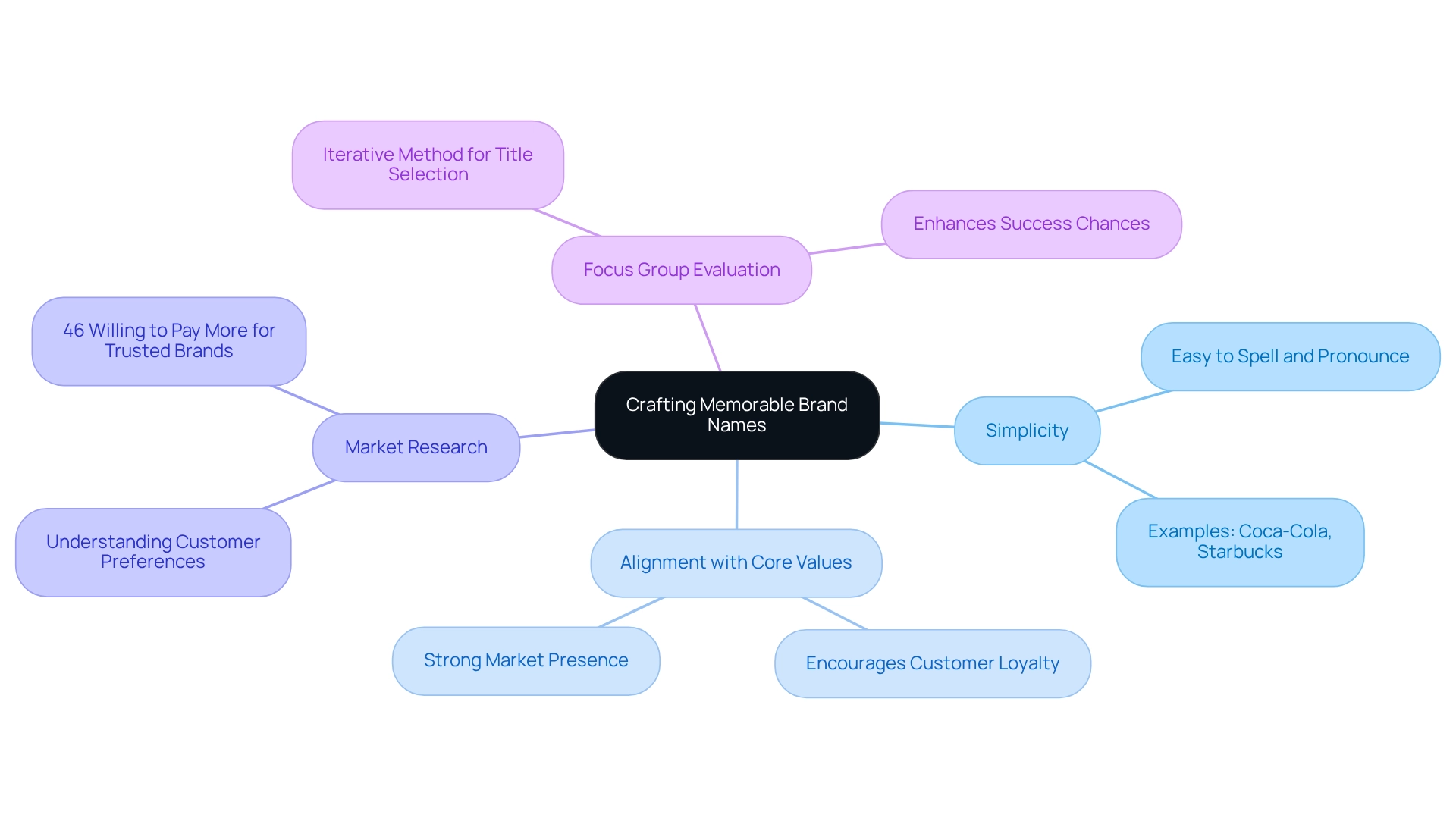
The Evolution of Brand Names: Case Studies of Name Changes
Brand labels evolve in response to shifting market dynamics, buyer preferences, and corporate strategies. A notable case is ‘Dunkin’ Donuts,’ which strategically shortened its name to ‘Dunkin” to emphasize its coffee offerings and expand its market appeal. This rebranding not only refreshed its image but also aligned with current trends favoring coffee-centric experiences.
In a similar vein, ‘Facebook’ has transitioned to ‘Meta’ to signify its ambitious shift towards the metaverse, underscoring its commitment to innovation and future growth.
These rebranding transformations illustrate the power of revitalizing a company’s identity and enhancing public perception. Research indicates that a positive customer experience can yield an impressive 73% increase in loyalty and sales, underscoring the critical importance of aligning corporate identity with consumer expectations during rebranding efforts. Furthermore, posts featuring images generate 650% greater engagement than text-only posts, highlighting the significant impact of visual marketing in capturing audience attention and enhancing perception.
Case studies of successful rebranding initiatives, such as those executed by WonderEight for brands like Mirinda and Quaker Oats, reveal the tangible benefits of strategic name evolution. WonderEight’s comprehensive branding and digital marketing solutions focus on creating compelling content that resonates with target audiences, ultimately enhancing experiences and driving engagement. For instance, WonderEight implemented a targeted social media campaign for Mirinda that significantly boosted visibility and consumer interaction.
As Ben Franklin wisely stated, “It takes many good deeds to build a reputation, and only one bad one to lose it,” emphasizing the necessity of maintaining a robust identity throughout the rebranding process. By refining their titles and marketing strategies, companies can attract new customers while preserving their relevance in an increasingly competitive landscape.
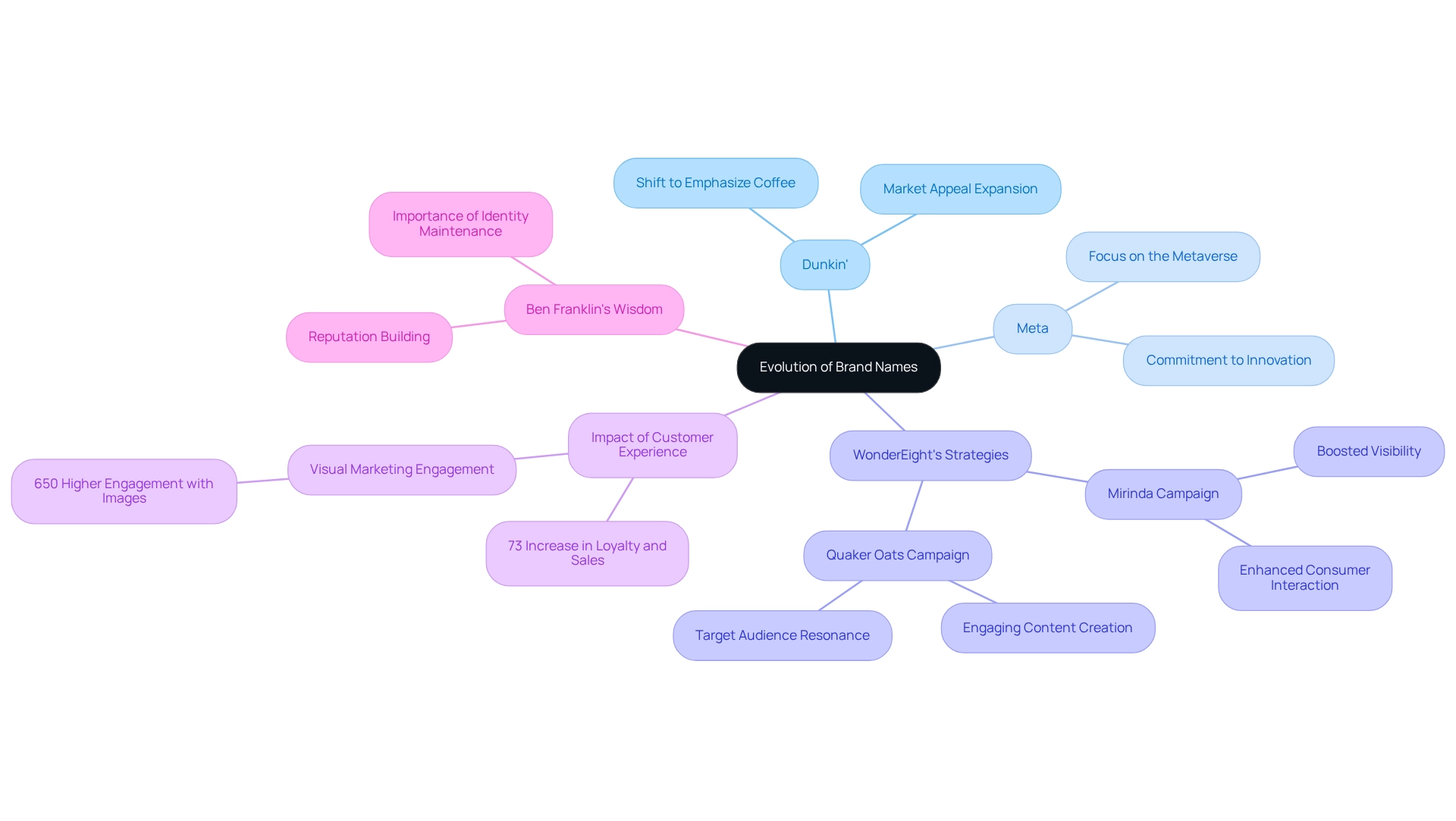
The Impact of Brand Names on Business Success and Marketing Strategies
The influence of labels on business success is both significant and complex. An engaging product name, akin to those of leading brands, not only enhances visibility within the industry but also cultivates customer loyalty and drives sales. Industry giants like Amazon and Apple exemplify this, having solidified their positions as market leaders largely due to their strong corporate identities.
Studies reveal that 68% of companies acknowledge that consistency in their image contributes to revenue growth; however, many struggle to implement effective guidelines. A compelling case study underscores that maintaining a unified corporate identity is essential for bolstering customer trust and income.
Moreover, impactful product titles are fundamental to marketing strategies, significantly influencing promotional success and consumer engagement. Statistics indicate that 81% of individuals visit a company’s website after encountering it on social media, highlighting the critical importance of a robust online presence. Organizations that prioritize the creation of a strong identity often experience enhanced customer loyalty and improved profitability, reinforcing the necessity of strategic identity management.
As we look towards 2025, the correlation between strong identities and business success remains evident, with 94% of marketers recognizing personalized marketing as beneficial for identity development. This underscores the role of labels in fostering meaningful interactions with clients, as 70% of individuals express a willingness to engage with companies through chatbots. Additionally, Natalya Jaime points out that research from The Design Council shows that 73% of consumers make purchasing decisions based on a product’s or service’s visual appeal, further emphasizing the importance of product identities.
At WonderEight, client success stories, such as the identity enhancement for Castania and the digital initiative for Motorola, showcase quantifiable results for clients, illustrating how powerful identities can lead to significant business outcomes. WonderEight’s innovative marketing solutions have enabled diverse clients across various sectors to enhance their identities and achieve their business goals. Ultimately, well-known brand names not only drive sales but also foster customer loyalty, establishing them as a vital element of any successful marketing strategy.
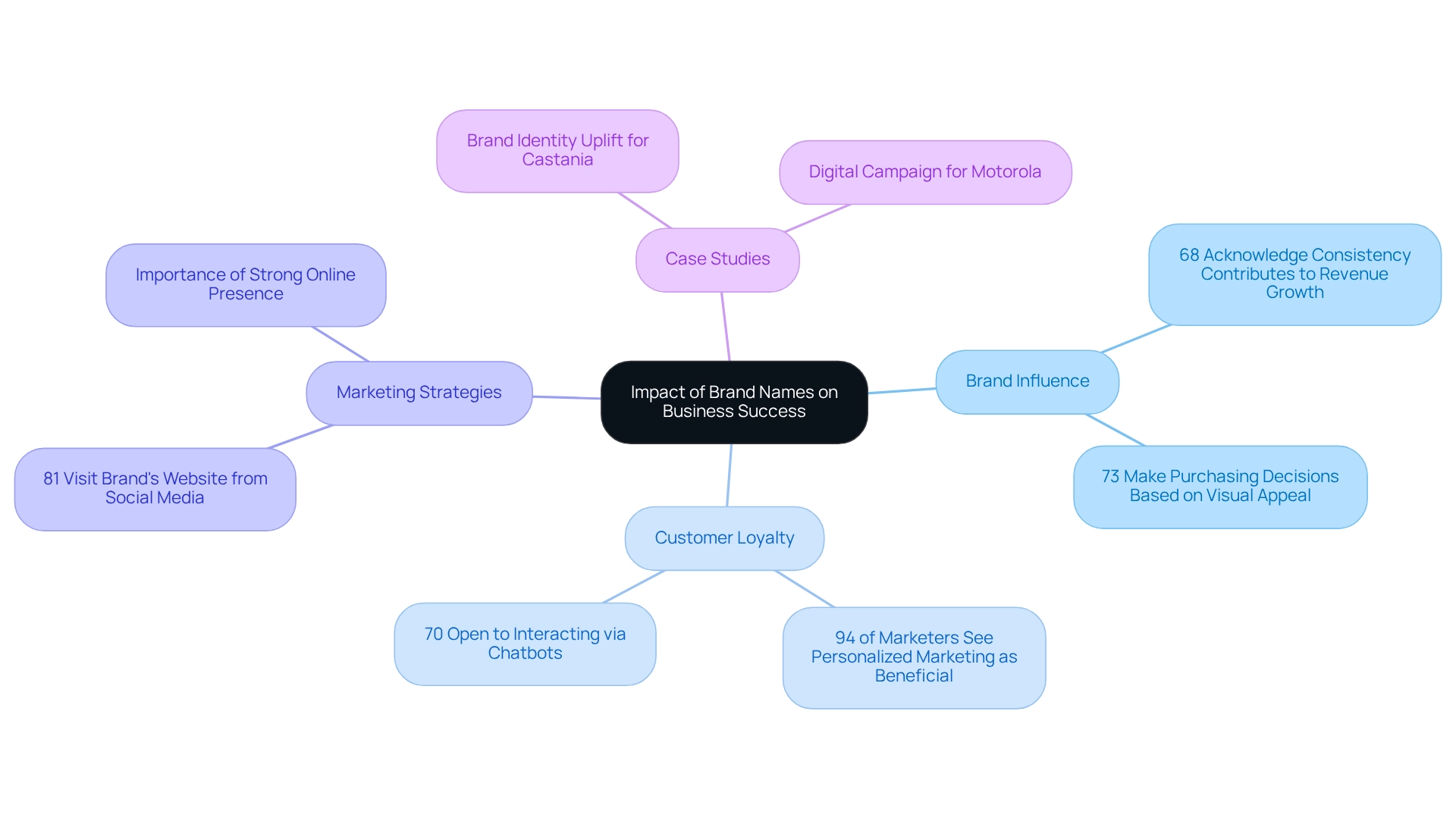
Challenges in Brand Management: Consistency and Market Adaptation
Brand management in 2025 confronts significant challenges, particularly in maintaining consistency across diverse platforms and adapting to ever-evolving market dynamics. Companies must ensure that their branding efforts resonate with their core values and messaging, a task that becomes increasingly complex in a fast-paced environment. As buyer preferences shift, companies must demonstrate flexibility in their strategies while preserving their identity.
Consider ‘Old Spice’ as a prime example of successful reinvention; the company effectively modernized its image to attract younger audiences without compromising its foundational essence.
Understanding the target market is essential for successful branding, as it enables businesses to customize their messaging and strategies to align with buyer expectations. Statistics indicate that 68% of consumers appreciate reading about companies they find intriguing, underscoring the significance of captivating narratives in company management. Furthermore, a case study on employer image reveals that 69% of job candidates are likely to reject offers from companies with a poor reputation, emphasizing the critical role of perception in attracting talent.
This aligns with professional viewpoints, including that of marketing technology specialist Krunal Vaghasiya, who observes that “value reflects the entity’s worth, its standing in the industry, and customer loyalty.”
As of 2023, there are 88.2 million active registered trademarks worldwide, with U.S. companies holding 3.5 million of these trademarks. This statistic illustrates the competitive environment that companies are navigating in 2025. To address these challenges, companies must implement strategies that permit adaptability and responsiveness to changes in the industry.
WonderEight provides extensive digital and technology solutions, such as social media strategy, digital audits, and e-commerce development, which can enhance presence and promote long-term success. For instance, WonderEight employs a data-driven approach in its digital audits to identify crucial areas for enhancement, ensuring companies can adjust effectively to marketplace changes. Successful examples include companies that have adapted their branding strategies to align with shifting consumer expectations, thereby enhancing their market presence.
By proactively addressing these challenges with integrated marketing solutions, companies can not only enhance their identity but also ensure ongoing engagement with their target audiences. Testimonials from satisfied clients further illustrate WonderEight’s effectiveness in driving brand success.
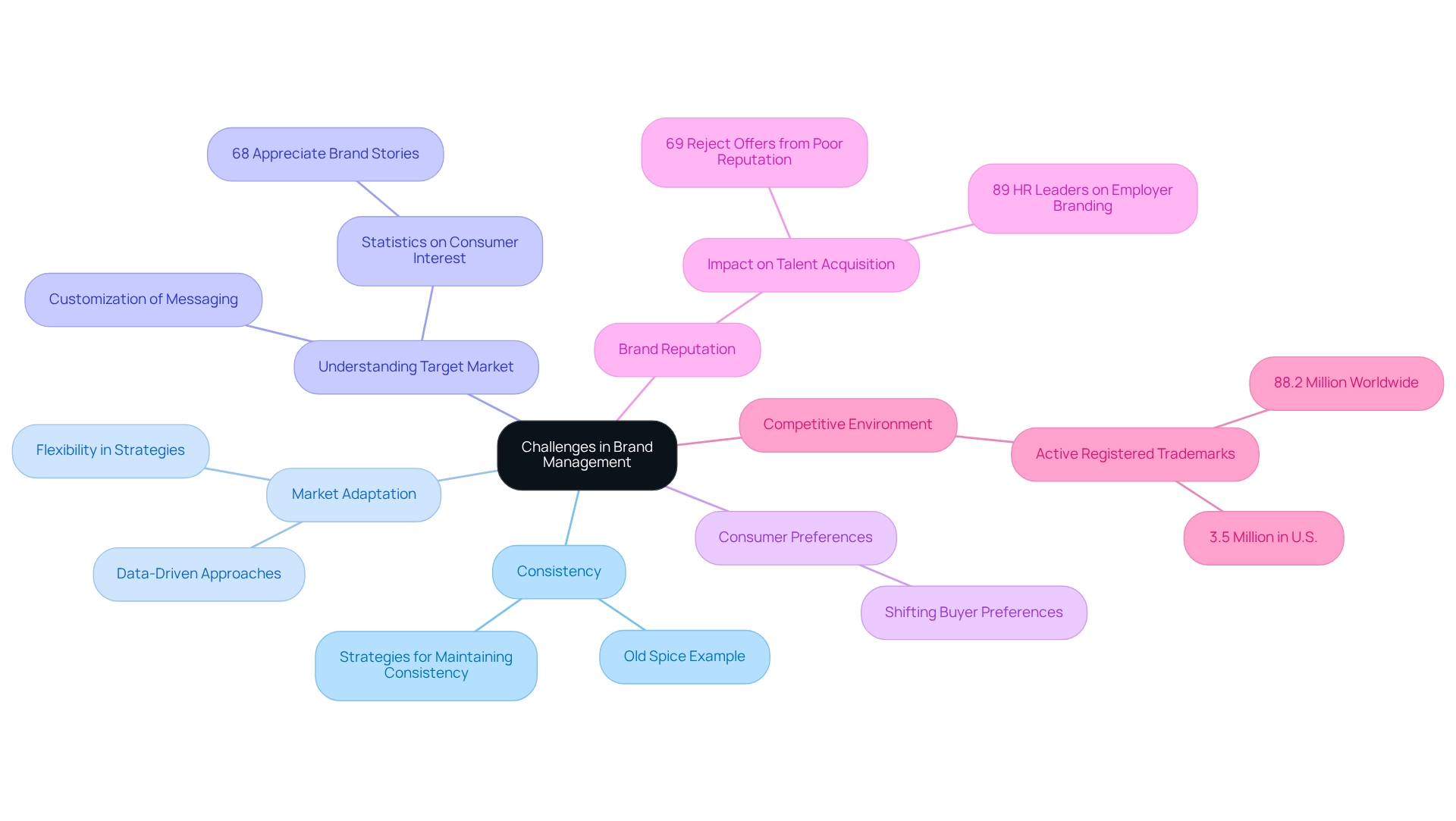
Conclusion
A strong brand name transcends being merely a label; it serves as a powerful tool that shapes consumer perceptions and drives business success. The significance of brand names in today’s competitive landscape is paramount. They embody a company’s essence and values, fostering emotional connections that lead to increased customer loyalty and heightened market visibility. Iconic examples like Apple and Nike illustrate how strategic branding can differentiate companies in a crowded marketplace, underscoring the necessity for businesses to meticulously craft their brand identities.
The psychology behind brand names reveals that simplicity, emotional resonance, and compelling narratives are crucial in shaping consumer behavior. Brands that effectively communicate their stories not only enhance their market appeal but also build trust and credibility among diverse demographics. Various case studies demonstrate that a well-executed branding strategy can yield significant advantages, including improved customer retention and increased profitability.
Navigating the challenges of brand management demands agility and consistency, particularly in adapting to evolving consumer preferences and market dynamics. By implementing best practices in branding—such as thorough market research and testing—companies can create memorable names that resonate with their target audiences. Ultimately, the interplay between effective branding and business success emphasizes the importance of investing in brand identity as a critical component of any marketing strategy. As the marketplace continues to evolve, businesses must prioritize their branding efforts to cultivate lasting relationships with consumers and achieve sustainable growth.
Frequently Asked Questions
What role do brand labels play in a company’s identity?
Brand labels embody a company’s essence, values, and commitment to its customers, serving as a pivotal differentiator that nurtures customer loyalty and amplifies visibility in a competitive market.
How do emotional connections with brands influence consumer behavior?
Emotional connections with prominent brand names significantly influence purchasing decisions, highlighting the necessity for companies to invest in crafting memorable and impactful identities.
What is the trust disparity among different income demographics regarding brand labels?
Only 29% of low-income shoppers place their trust in labels, compared to 38% of affluent consumers, indicating a critical need for companies to foster trust and credibility across diverse demographics.
How much do companies typically invest in logo design?
The financial commitment to logo design can range from entirely free to millions of dollars, reflecting the serious investment organizations make in their identity and its impact on consumer perception.
What effects do strong brand identities have on employee retention?
Firms that emphasize employer branding can experience employee retention rates soaring by as much as 28%, which helps preserve talent and can cut hiring costs by up to 50%.
Why are compelling brand stories important in today’s market?
Compelling brand stories enhance market appeal, forge emotional connections with consumers, and are among the top factors influencing content effectiveness, as highlighted by research showing 57% of marketers emphasizing their importance.
How has the trend of data storytelling evolved recently?
The trend of data storytelling is anticipated to grow, with a remarkable 233% increase noted in recent years, suggesting brands must adapt their strategies to integrate meaningful, narrative-driven content.
What impact does storytelling about sustainability and diversity have on consumer behavior?
Organizations that prioritize sustainability and diversity in their storytelling find that consumers are more inclined to spend, reflecting an upward trend in purchasing behaviors.
How can businesses leverage their unique narratives?
By understanding and harnessing the stories behind their identities, businesses can craft compelling narratives that reinforce their brand identity and cultivate deeper connections with their audience, ultimately driving engagement and loyalty.



